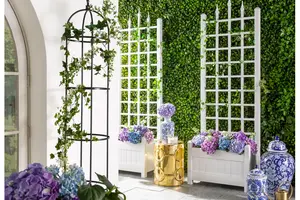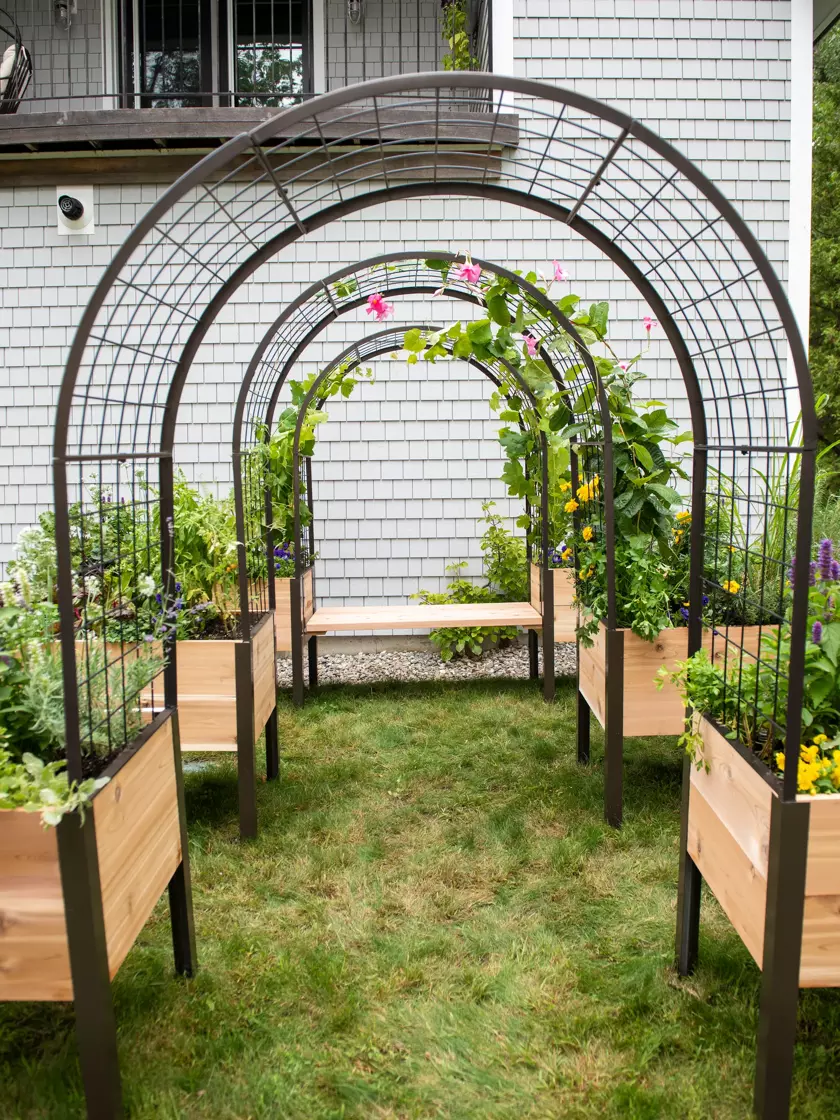Blossom and Thrive: Your Garden's Best Friend - Trellises
In this informative article, we delve into the world of trellises, exploring their history, types, benefits, and practical usage in your garden. From the ancient Hanging Gardens of Babylon to modern-day vertical gardening, we uncover the trellis's fascinating journey through time. Discover the diverse range of trellis types, such as wooden, metal, vinyl, wire, arched, and wall-mounted trellises, each offering unique qualities and aesthetics. Learn about the numerous advantages of incorporating trellises into your outdoor space, from maximizing vertical gardening space to creating privacy and adding visual appeal. We also provide tips on how to effectively use trellises in your garden, making it easier to choose the right trellis, select suitable plants, and maintain them. Enhance your garden's beauty and functionality with the timeless and versatile trellis.
A Comprehensive Guide to Trellises.

Trellises have been an essential element in gardening and landscaping for centuries. These simple structures not only enhance the aesthetics of your garden but also serve several practical purposes. Trellises can support climbing plants, create privacy, and define spaces in your outdoor area.
The History of Trellises
Trellises have a long and storied history, dating back to ancient civilizations. The concept of trellises can be traced to the hanging gardens of Babylon, one of the Seven Wonders of the Ancient World. These early trellises were used to support vines and create lush, elevated gardens. Over time, trellises evolved and became more ornamental, featuring intricate designs and craftsmanship. Today, trellises are both functional and decorative elements in gardens around the world.

Types of Trellises
Trellises come in various styles and materials, allowing you to choose one that suits your garden's aesthetics and the plants you wish to support. Here are some common types of trellises:
a. Wooden Trellises: Wooden trellises are popular due to their natural look and durability. They can be stained or painted to match your garden's color scheme and come in various designs.
b. Metal Trellises: Metal trellises are sleek and modern, often made from materials like iron or steel. They are durable and can support heavy vines.
c. Vinyl Trellises: Vinyl trellises are low-maintenance and weather-resistant. They are easy to clean and come in various styles.
d. Wire Trellises: Wire trellises are simple and unobtrusive, ideal for training climbing plants. They consist of wire grids or cables that can be attached to a wall or freestanding frame.
e. Arched Trellises: Arched trellises create beautiful entryways or tunnels in your garden. They add a touch of elegance and can support climbing roses or other flowering vines.
f. Wall-Mounted Trellises: These trellises are designed to be attached to walls or fences, maximizing vertical gardening space.
Benefits of Using Trellises
Trellises offer numerous benefits for your garden and outdoor space:
a. Vertical Space Utilization: Trellises allow you to maximize your gardening space by growing vertically. This is especially valuable in smaller gardens.
b. Plant Support: They provide sturdy support for climbing plants, such as cucumbers, peas, beans, and various flowering vines.
c. Privacy and Screening: Trellises can create privacy by blocking unwanted views or defining specific garden areas.
d. Aesthetic Appeal: Trellises add an element of beauty and structure to your garden, enhancing its overall appearance.
e. Shade and Cooling: Some trellises can be used to create shade or cooling areas, particularly in hot climates.
How to Use Trellises in Your Garden
Here are some tips on effectively using trellises in your garden:
a. Choose the Right Trellis: Select a trellis that complements your garden's style and can support the type of plants you want to grow.
b. Placement: Determine the ideal location for your trellis, considering factors like sunlight, wind, and the needs of your plants.
c. Plant Selection: Choose climbing or vining plants that are well-suited for trellis support, such as tomatoes, cucumbers, jasmine, or wisteria.
d. Maintenance: Regularly prune and train your plants to ensure they grow correctly on the trellis. This will help prevent overcrowding and promote healthy growth.
e. Decorate and Accessorize: Consider adding decorative elements like hanging baskets or lighting to enhance the trellis's visual appeal.
Materials Used In Setting Up A Trellis
When setting up a trellis for your garden or outdoor space, you'll need various materials, depending on the type of trellis you choose and its specific design. Here's a list of common materials used in setting up a trellis:
Trellis Structure:
- Wood: Typically cedar, redwood, or pressure-treated lumber for a natural and traditional look.
- Metal: Steel, iron, or aluminum for a more modern and durable option.
- Vinyl: Low-maintenance and weather-resistant, ideal for easy installation.
Fasteners:
- Screws or nails: Used to attach the trellis structure to walls, fences, or other surfaces.
- Brackets: For wall-mounted trellises, you may need brackets to secure the structure in place.
Anchors (for freestanding trellises):
- Concrete: Used to anchor wooden trellises into the ground.
- Metal stakes: These are often used to secure lightweight trellises in the soil.
Plants and Soil:
- Climbing plants or vines: Choose plants that are suitable for your climate and garden aesthetics.
- Potting soil or garden soil: To provide a good growing medium for your plants.
Tools:
- Hammer or screwdriver: For fastening the structure.
- Level: To ensure that the trellis is installed straight.
- Shovel: If you are installing a freestanding trellis, you'll need a shovel to dig a hole for anchoring.
Optional Decorative Elements:
- Paint or stain: To customize the appearance of wooden trellises.
- Hanging baskets: To add visual interest to the trellis.
- Outdoor lighting: For evening ambiance.
- Trellis toppers or finials: To enhance the decorative aspect of the trellis.
Safety Gear:
- Safety glasses and gloves: To protect your eyes and hands when working with materials and tools.
The specific materials you'll need may vary depending on your project's size and design, so be sure to plan accordingly and consider the specific requirements of your chosen trellis and plants.

(FAQ)
What is called trellis?
What is the definition of a trellis?
What is the difference between a lattice and a trellis?
What is an example of trellis?
Why do people use trellis?
Why is it called trellis?
How do you place a trellis?
How do you put a trellis in place?
Can trellis stand alone?
What makes a good trellis?
What is called trellis?
A trellis is a framework or structure typically made of wood, metal, or other materials that is designed to support climbing plants, vines, or flowers. It provides a stable surface for plants to grow vertically, enhancing their aesthetic appeal and optimizing garden space.
What is the definition of a trellis?
A trellis is a garden or outdoor structure consisting of a framework with open, often interwoven, patterns. Its primary purpose is to support and guide the growth of climbing plants while also serving as a decorative element in gardens and landscapes.
What is the difference between a lattice and a trellis?
Lattice and trellis are similar in that they are both used to support climbing plants and create visual interest in gardens. The key difference is in their construction: a lattice is a grid-like panel with evenly spaced crisscrossed slats, while a trellis is a more open framework with larger openings that may be arched or ornamental.
What is an example of trellis?
An example of a trellis might be an arched wooden structure in a garden, designed to support climbing roses. Another example could be a metal framework against a wall, supporting a variety of flowering vines, like wisteria or jasmine.
Why do people use trellis?
People use trellises for several reasons, including:
- Supporting climbing plants, allowing them to grow vertically.
- Maximizing garden space, especially in smaller gardens.
- Creating privacy by blocking unwanted views or defining garden areas.
- Enhancing the aesthetic appeal of their outdoor spaces.
- Providing shade and cooling areas, particularly in hot climates.
How do you place a trellis?
To place a trellis effectively:
- Choose the location, considering factors like sunlight, wind, and the needs of your plants.
- Ensure it is stable, whether freestanding or attached to a wall or fence.
- Dig a hole for a freestanding trellis or use appropriate anchors for wall-mounted ones.
- Secure the trellis in place and make sure it's level.
- Train your plants to grow onto the trellis as they grow.
How do you put a trellis in place?
To put a trellis in place, follow these steps:
- Position the trellis where you want it in your garden.
- For freestanding trellises, dig a hole to the appropriate depth and place the trellis securely in the hole.
- For wall-mounted trellises, use appropriate hardware to attach it to a wall or fence.
- Ensure that the trellis is level and stable.
- Train your chosen climbing plants to grow on the trellis.
Can trellis stand alone?
Yes, trellises can stand alone as freestanding structures. These are often placed in gardens or other outdoor spaces to create vertical gardening opportunities, define areas, or add decorative elements.
What makes a good trellis?
A good trellis should be:
- Sturdy and durable, capable of supporting the weight of climbing plants.
- Appropriate for the intended plants and the garden's aesthetic.
- Well-placed to receive adequate sunlight and airflow.
- Well-maintained, with regular pruning and plant training to ensure healthy growth.
- Designed to enhance the visual appeal of your garden or outdoor space.
Trellises have a rich history and continue to be a versatile and functional addition to any garden or outdoor space. Whether you want to support climbing vegetables, create privacy, or simply beautify your garden, trellises offer a solution for every gardener. With a wide variety of styles and materials available, you can find the perfect trellis to suit your needs and enhance the overall aesthetics of your outdoor space.



